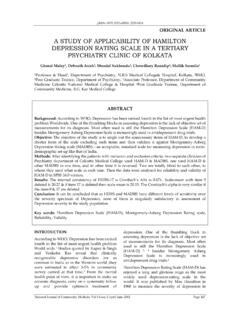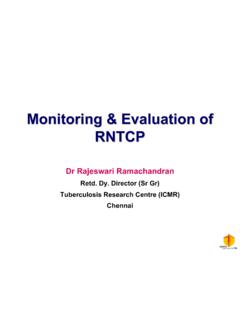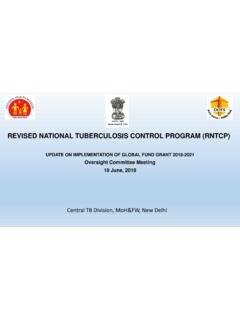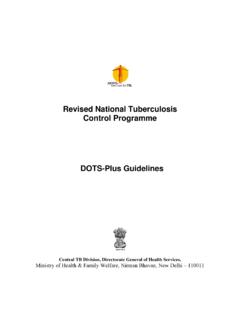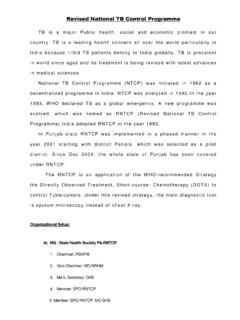Transcription of ASSESSMENT OF DIRECT OBSERVE TREATMENT SHORT …
1 Open Access Journal pISSN 0976 3325 eISSN 2229 6816 national Journal of Community Medicine Volume 5 Issue 2 Apr June 2014 Page 195 Original Article ASSESSMENT OF DIRECT OBSERVE TREATMENT SHORT COURSE ( dots ) IMPLEMENTATION AND TREATMENT CARD UPDATE BY DOT PROVIDERS UNDER revised national tuberculosis control PROGRAMME IN RAIPUR DISTRICT OF CHHATTISGARH STATE Dhiraj Bhawnani1, Nirmal Verma2, Gopal P Soni2, Anjana Tiwari1 Financial Support: None declared Conflict of interest: None declared Copy right: The Journal retains the copyrights of this article. However, reproduction of this article in the part or total in any form is permissible with due acknowledgement of the source. How to cite this article: Bhawnani D, Verma N, Soni GP, Tiwari A.
2 ASSESSMENT of DIRECT OBSERVE Treat-ment SHORT Course ( dots ) Implementa-tion and TREATMENT Card Update By Dot Providers Under revised national Tu-berculosis control Programme in Raipur District of Chhattisgarh State. Natl J Community Med 2014; 5(2):195-198. Author s Affiliation: 1 Assist. Prof, Dept. of Community Medicine, CM Medical College, Durg ( ); 2 Associate Prof, Dept. of Com-munity Medicine, Pt. JNM, Medical College, Raipur ( ) Correspondence: Dr Dhiraj Bhawnani, Email: Date of Submission: 31-01-14 Date of Acceptance: 16-05-14 Date of Publication: 30-6-14 ABSTRACT Background: dots is the backbone of RNTCP and its proper implemen-tation is the key of success of programme, in which DOT providers play a crucial role. Chhattisgarh is unexplored area related to research in na-tional health programme like RNTCP which need due priority, hence district level health system research relevant to TB is reason to select cur-rent research study.
3 So the present study was conducted to assess the dots implementation and TREATMENT card update by DOT providers underRevised national tuberculosis control Programmein Raipur dis-trict of Chhattisgarh state. Methodology: A cross sectional observational community based study was conducted usingsimple random sampling in all 33 Designated Mi-croscopic Centres (DMC s) of Raipur district from November 2011 to October 2012. During the study, 136 DOT providers were included and predesigned and pretested proforma was used as a study tool. The ob-tained data were analyzed using appropriate statistical test. Results: Majority of DOT providers were between 30-40 year and were female. Majority ( ) were mitanin (ASHA).
4 The modular train-ing was received by only of DOT providers and rest were spot trained. Proper implementation of dots was seen in DOT centres & TREATMENT cards update was found in only. Conclusion: Proper dots implementation and TREATMENT card update was very low, so there is urgently need to ensure the same. Key words: DOT providers, RNTCP, TREATMENT card, Raipur. INTRODUCTION tuberculosis (TB) is one of the most ancient disease and continues to be a major public health problem of world even today.(1) In 2009 the worldwide prevalence of TB was 164 cases per 100,000 population, Incidence of TB 140 cases per 100,000 population, mortality due to TB was 19 cases per 100,000 population.(2) In 2009 in India Prevalence of TB was 249 cases per 100,000 population, Incidence of TB 168 was cases per 100,000 population, mortality due to TB was 23 per 100,000 population.
5 (4) Every year approximately million people develop TB and nearly 400,000 die from it. (3) tuberculosis is a barrier to socio-economic devel-opment. (1) RNTCP was started in Chhattisgarh in selected dis-tricts in 15/08/2002 and extended to entire state by 15/08/2004. dots is the backbone of RNTCP and its proper implementation is the key to success of pro-gramme. The DOT providers are link person between TB Health Visitor/Health worker and patients. Their performance determines the outcome of TB cases. Their role crucial in completing the TREATMENT course and increasing the cure rate of the TB cases which in turn reduces mortality due to TB and development of multi drug resistance cases.
6 There is need to assess the proper implementation of programme at operational level and the grass root level realities of TB TREATMENT . With this background, the present study was con-ducted to assess the dots implementation and treat-ment card update by DOT providers in Raipur district. METHODOLOGY Study Centre Department of Community Medicine, Pt Medical College, Raipur ( ), India. Study Open Access Journal pISSN 0976 3325 eISSN 2229 6816 national Journal of Community Medicine Volume 5 Issue 2 Apr June 2014 Page 196 Area:-Raipur district (all 33 Designated Microscopic Centres). Study Design:-Cross sectional observational community based study. Sampling technique:- Sim-ple random sampling. Study subjects-136 (10% of DOT providers from each DMC).
7 Study Duration- 1 year (Nov-2011 to Oct-2012). Study Tool- Predesigned and Pretested Proforma. Consent- Prior written Per-mission was taken from office concern & Informed consent from subjects. Study was conducted in old Raipur district which cur-rently has been divided into three districts. As per national guidelines of RNTCP list of tuberculosis units (TUs) and Designated microscopic centres (DMCs) was obtained from District tuberculosis Cen-tre, Raipur ( ).Ethical considerations were met through institutional ethical committee. Map of Study area (Raipur district) showing TUs & DMCs was prepared. The list of DOT providers was also obtained. Out of these DOT providers 10% from each DMC were randomly selected for study.
8 Predes-igned and pretested proforma was used for the Sur-vey. The TUs & DMCs were visited first. DOT providers were located with the help of TBHV/MPW. Home visits of DOT providers were made. They were as-sured of confidentiality then information was col-lected. Thus total 136 DOT providers were inter-viewed. Observation was made for supervised drugs administration by counting of used blister packs of TB drugs & matchingthe same with duration of TREATMENT , proper entries of these in the TREATMENT cards and timely update of TREATMENT card. ASSESSMENT of proper dots implementationand TREATMENT card update were done by making check point grading of 1, 0(1 for pres-ence & 0 for absence). Collected data was checked for its completeness and correctness.
9 Data was compiled in MS excel &analyzed with the help of medcalc online statistical calculator and Chi square test were applied to test the statistical significance and p value of < was considered statistically significant for interpretation of finding. Tool to assess the proper dots implementation During the intensive phase (IP) of TREATMENT , each and every dose of medicine is to be taken under DIRECT ob-servation of the DOT Provider. So there should be 24 and 36 blister packs in IP pouch of Cat I and II Patient wise box (PWB) respectively at any time during treat-ment. (3) If blister pack is missing by count , that means dots is not properly implementing. During the Continuation Phase (CP), the first dose of the week must be administered under DIRECT observa-tion.
10 The patient collects rest of the drugs for the week from the DOT Provider and consumes them at home. The following week, the patient comes with the empty blister pack, hands it over to the DOT Provider, takes the first dose under DIRECT observation and collects drugs for the rest of the week to be consumed at home. So there should be 17 and 21 blister packs in CP pouch of Cat I and II PWB respectively at any time during TREATMENT . (3) The DOT Provider must collect the empty blister pack and keep it in the PWB. If blis-ter pack is missing by count, that means dots is not properly implementing. RESULTS Majority of the DOT providers were female and 50% were aged between 30-40 years. of DOT provid-ers got their schooling till higher secondary level while had their education up to middle school.



